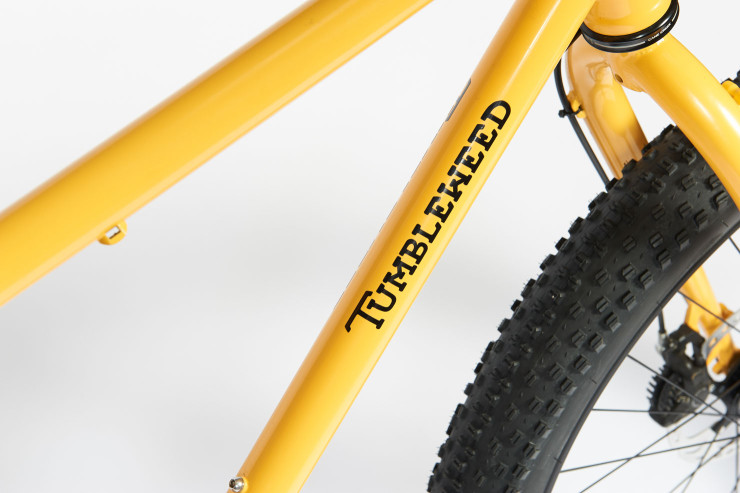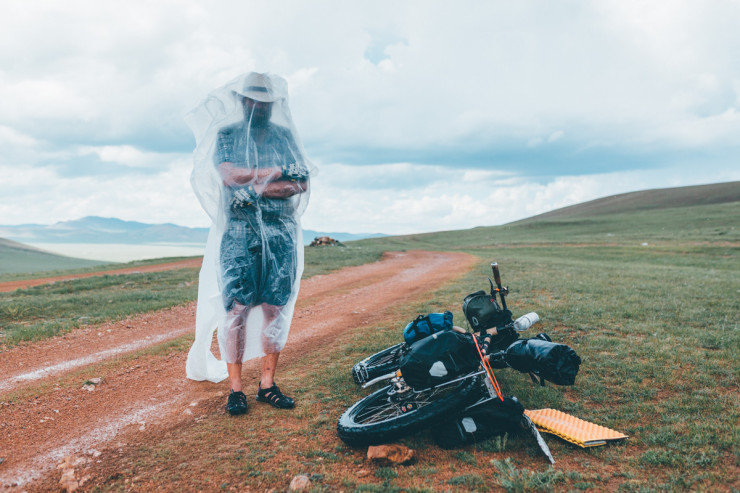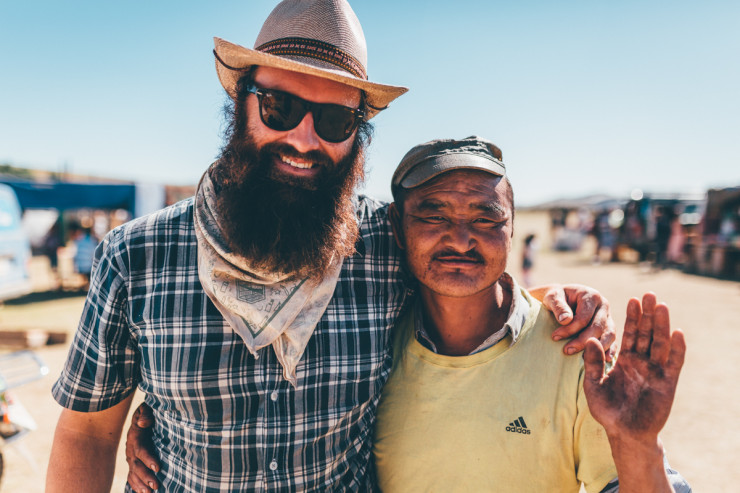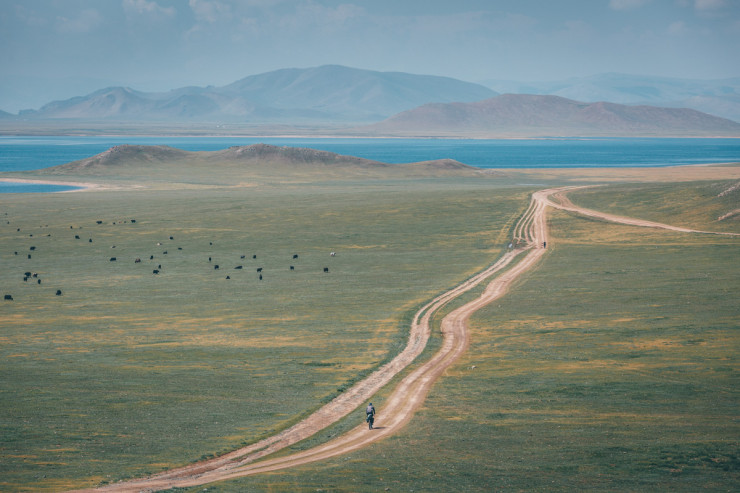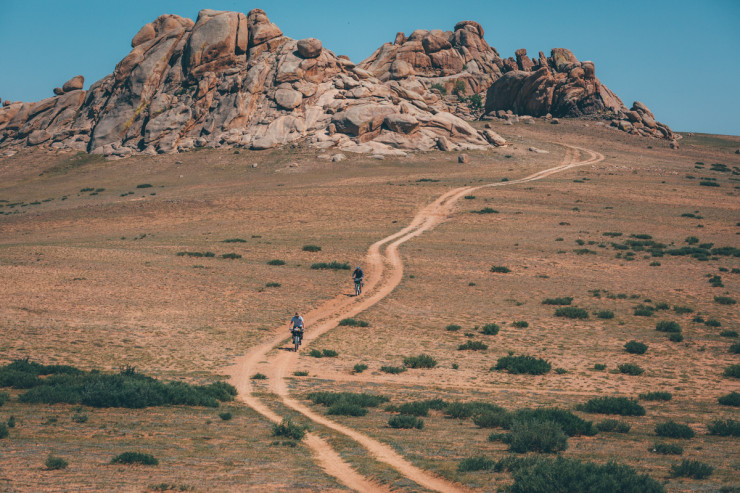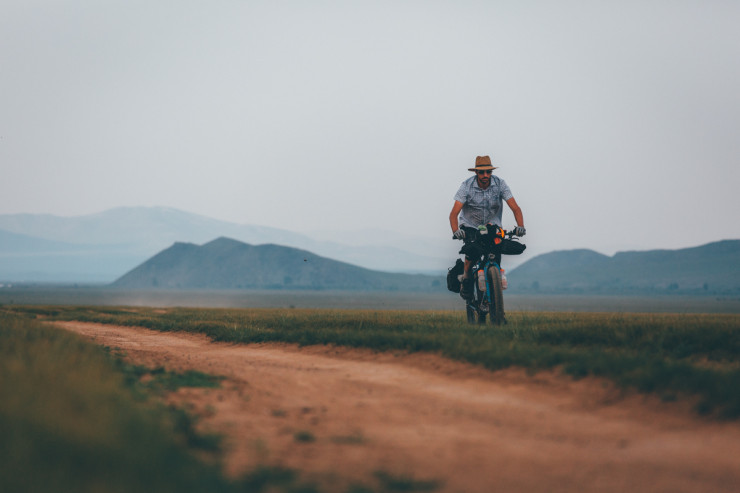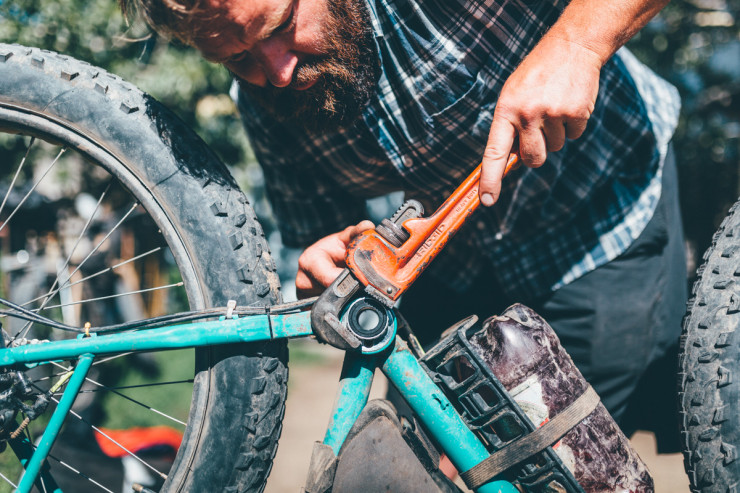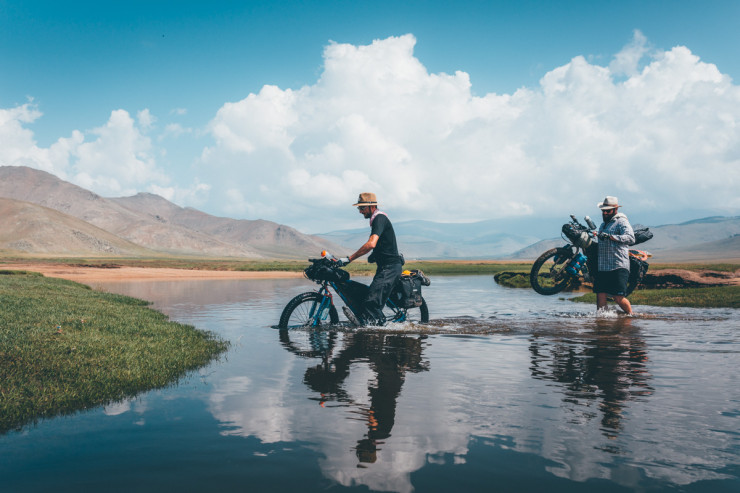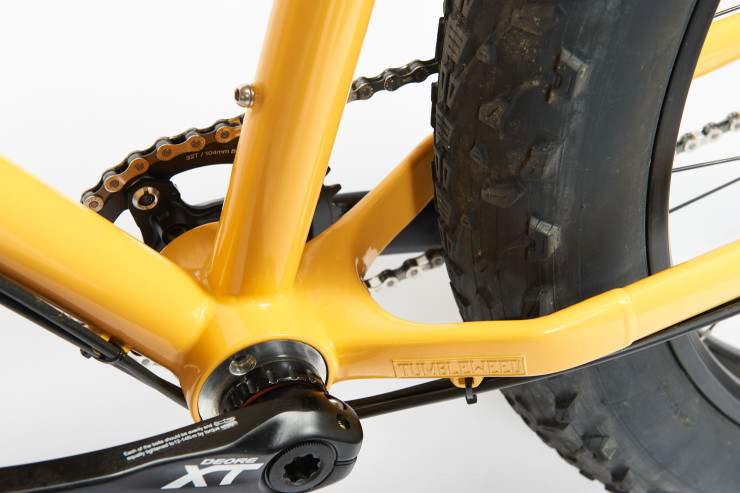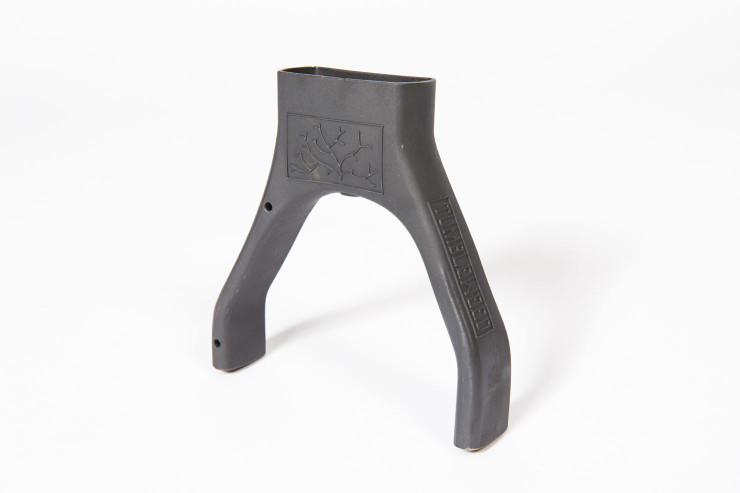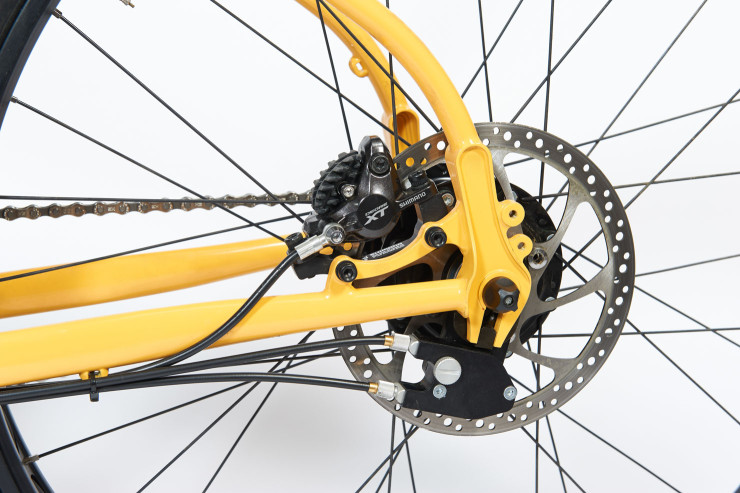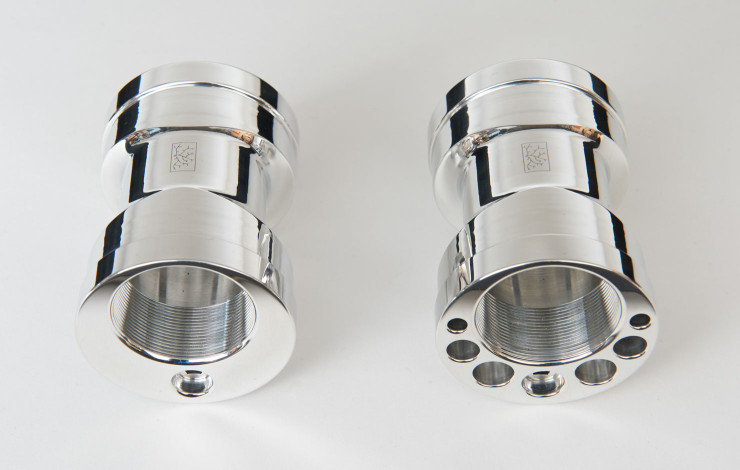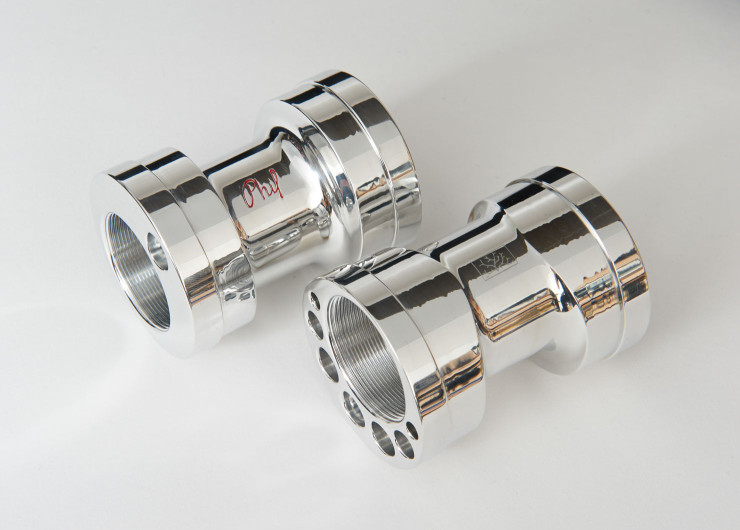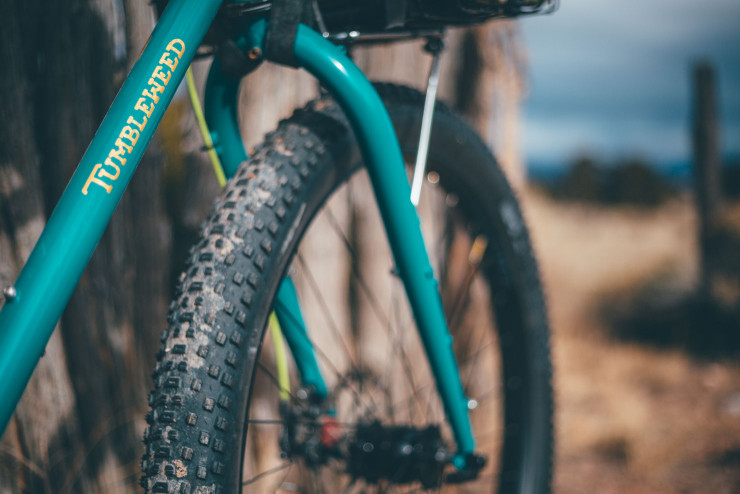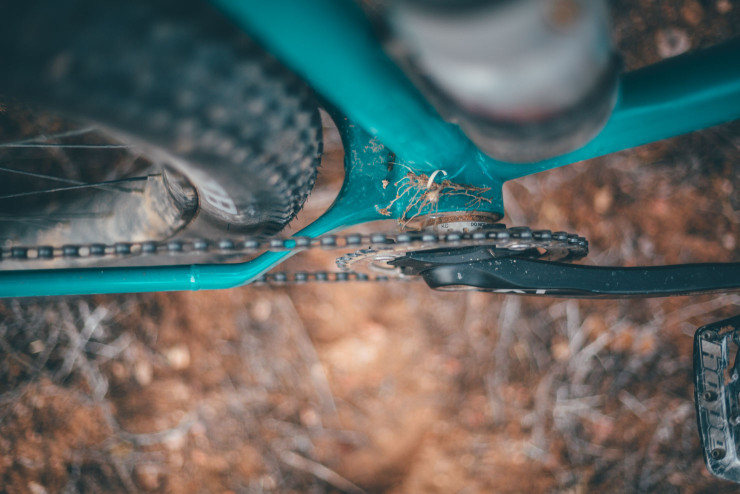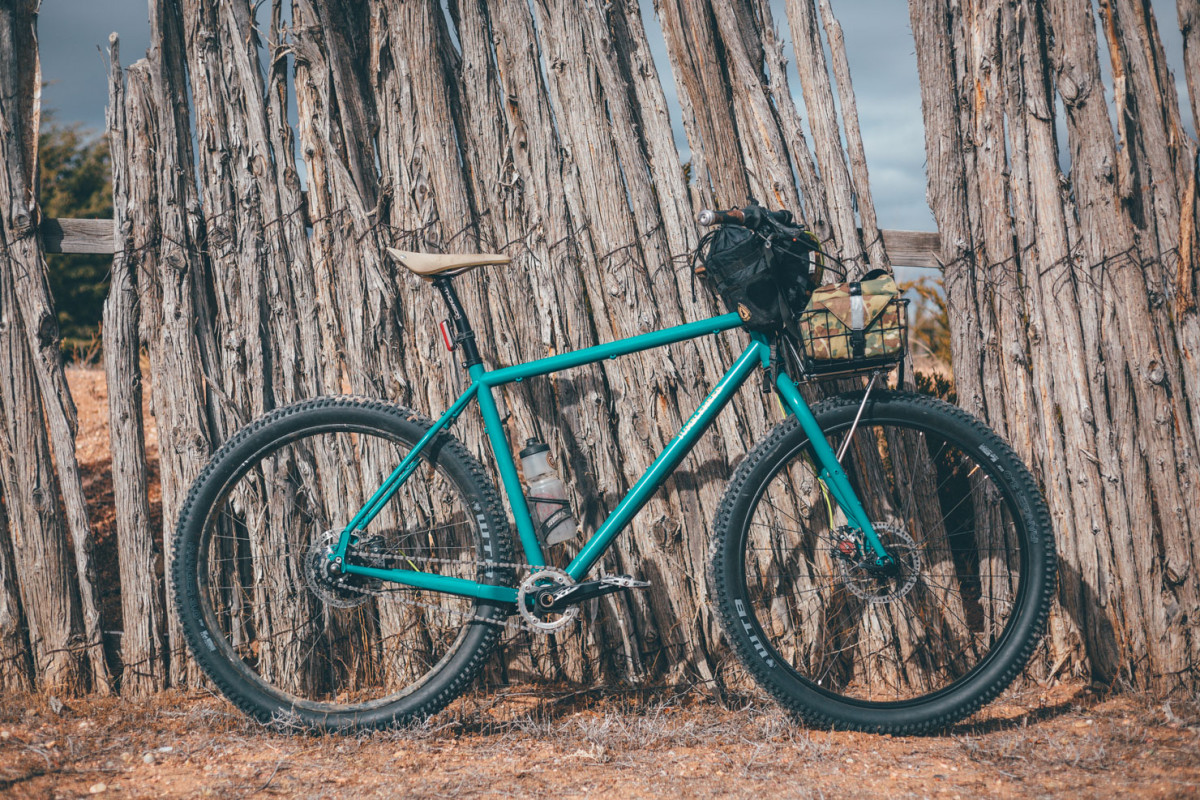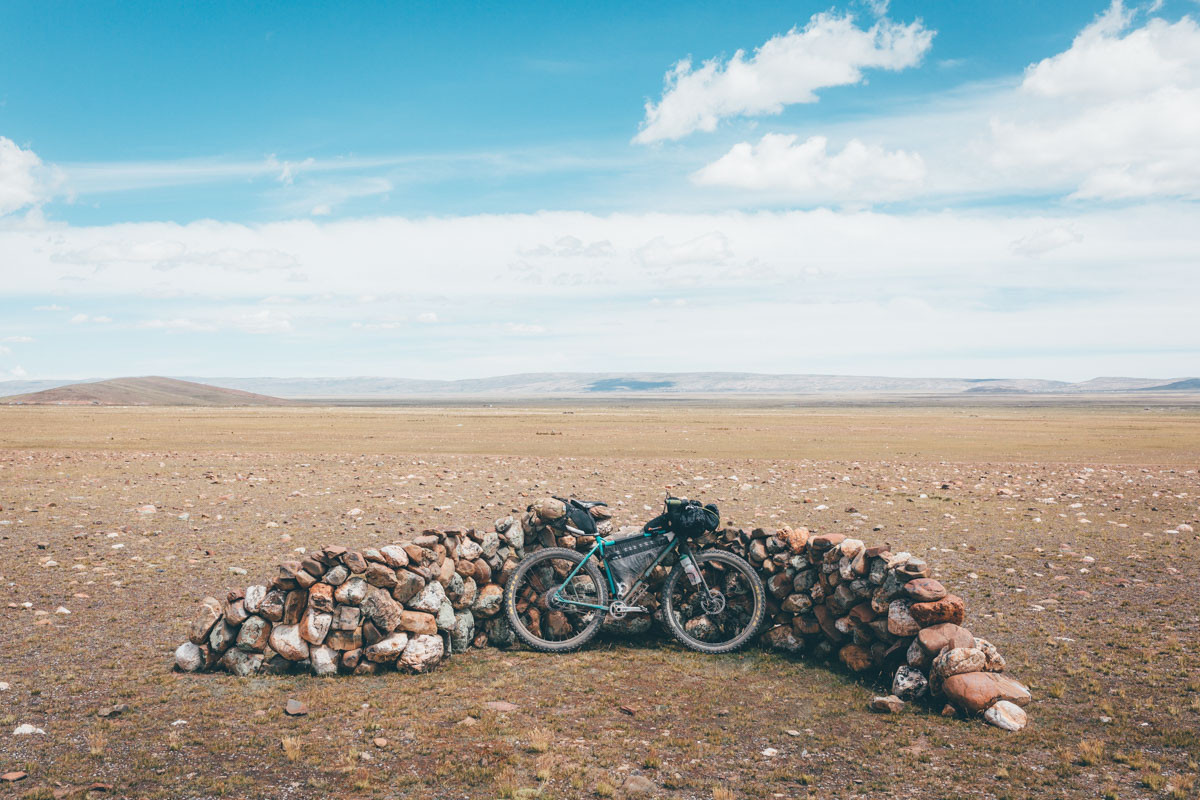Introducing Tumbleweed Bicycle Co: Meet the Prospector
The Prospector is Tumbleweed’s upcoming fat/plus/Rohloff do-it-all expedition bike. We find out more about the company, learn what it takes to set up a micro brand, and share some first impressions on the bike itself.
PUBLISHED Jan 18, 2017
Tumbleweed Bicycle Co is a new brand from Oakland, California and its inaugural model, the Prospector, has bikepacking written all over it. Or rather touring, expedition riding, trail riding and anything dirt-related in between.
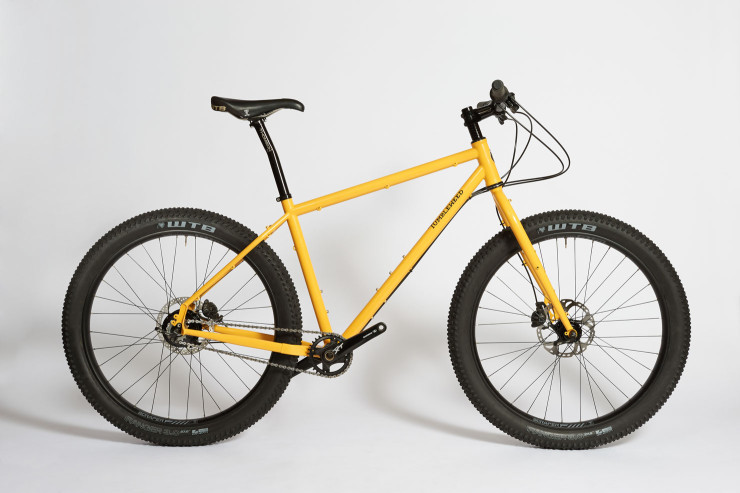
The Prospector’s headline feature is a custom yoke designed to allow its steel, Taiwanese-made, symmetrical frame accommodate fat tires – up to 4in in diameter – with a standard-width, über reliable Rohloff Speedhub. Translation? Without need for an extra-wide bottom bracket shell, there’s no increase in the distance between the pedals and the resulting Q Factor, a fat bike trait that’s irksome to many. But there’s more to it than that. For those who prefer a derailleur-themed drivetrain, there’s clearances 29+ and 27.5+ tires with easy-to-source 135mm hubs. Feeling rowdy? The frame features a suspension-corrected geometry with a dropper-post friendly seat tube. And to keep long distance touring folk happy, the Prospector includes a generously proportioned headtube to maximise framebag space, as well as all the necessary braze-ons for racks, panniers, and a myriad of water bottles. All of which makes for a very versatile bike, one that Tumbleweed promote as both a rugged, adaptable, backcountry explorer for all your worldly travels, and a fun rig around your local trails.
We’ll let company owner Daniel Molloy do the talking and explain how the Prospector came to be…

Tell us a little about your company. When was it launched and how did you decide on its name?
“Tumbleweed was launched in 2014, while I was working full time as the service manager at Montano Velo (now Broakland) in Oakland, California. We had a record player at the time and were listening a lot to an Elton John album called Tumbleweed Connection. I’d been thinking about a name that would capture the fun and adventurous nature of these bikes. ‘Tumbleweed’ really fit the bill. It made me think of wide open spaces and remote locations – and tumbleweeds even roll! It also happens to mean ‘steppe roller’ in German, so a very fitting name considering that my first big trip on a prototype bike was across the Mongolian Steppe.”
What’s your background in the bike industry?
“I began riding bikes as an adult in 2000 or 2001 after not having a bike since childhood. It was an instant obsession and I was soon riding everywhere! I started working in local bike shops in the Bay Area in 2005 and shortly after that I was hired by Rivendell, where I worked until I graduated college in 2008. During my time there Grant Petersen was an important mentor to me and still is to this day. His ideas have had a lasting influence on my values regarding bicycles, such as prioritizing tire clearance in design and paying attention to small details that most people don’t notice, as well as how to treat customers. We would often go on S24O campouts once a week when I worked there; I was the guy who would always say yes to a spontaneous campout. I decided to stay in the bike industry after graduating from college, with the fledgling idea that one day I would carve out my own little niche doing something I truly believed in. I’ve worked in a few great shops since then, and led trips for a summer with a local bike touring company, keeping an open mind as to what I wanted to do long term.”
What motivated you to start a brand of your own?
“I continually tinker with my bikes, building up a new one for each trip that I’ve done, even having a custom frame made at one point. I didn’t really consider starting my own brand until after a bike tour down Patagonia’s Carretera Austral, when I ran into the limitations of the fatbike I was riding there. I realized that all the bikes I’d built up felt compromised in some way, whether it was with parts compatibility or Rohloff hub integration into the frame or the ability to mount certain types or racks. I wanted a versatile bike that was purpose designed to accommodate a standard Rohloff Speedhub – which I’d been using for last seven years – without compromising the bike in any way. Most of the off-the-shelf frames that I’d mounted these drivetrains to worked but were not nearly as user-friendly as I’d have liked.
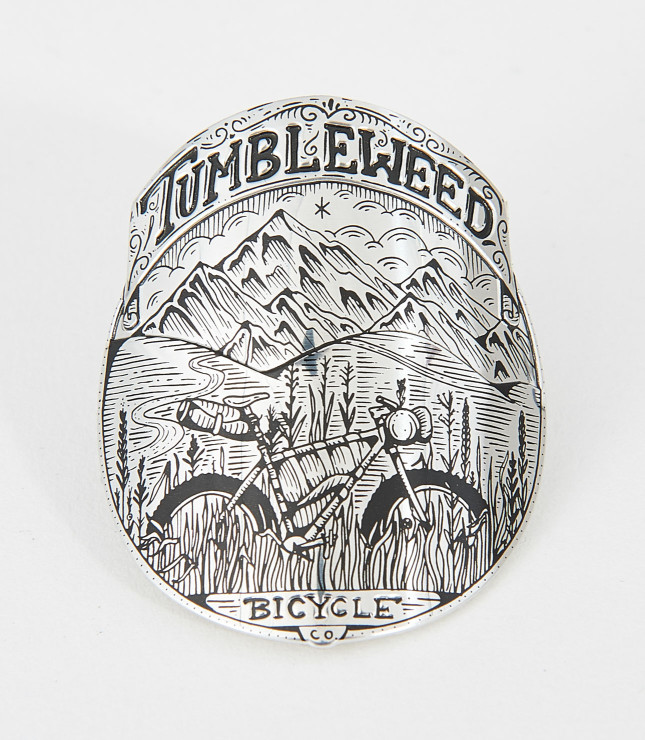
I love the way fatbikes ride and the places they can take you. But while traveling through South America, I began to realize that I was sensitive to the wide Q Factor (the distance between the feet on the pedals) that’s required for such tires. This was something I hadn’t appreciated on shorter trips. I took a look at the drivetrain I was using and the tire compatibility I wanted, and an idea started brewing in my head for a better execution in a new frame design. This was in early 2014. I brainstormed for the next six months, talking to industry friends and fellow bike nerds about what I wanted this new bike to be. This would eventually lead me on the path to starting my own company.”
What kind of trails do you ride and where have you toured? And how has this influenced your vision for the Prospector?
“I’ve made it a big priority in my life to take a month to six weeks at a time every year or two, to do self-supported trips in different parts of the world. As a bike mechanic I don’t make a lot of money, but I’ve been lucky to have some great bosses who were flexible in allowing me to take the time off.
My first long off road tour was the Great Divide Mountain Bike Route which I rode solo in 2008. That was a life changer, I spent three months doing it and never wanted it to end. In 2011 I rode the Northern Indian Himalayas from Manali to Leh for a month with close friends, another amazing trip. In 2014 I rode the Carreterra Austral from Puerto Montt to Tierra del Fuego in Chile and Argentina, and in 2015 we rode prototype Prospectors across Mongolia. I’ve been really interested in bike camping and touring since around 2004. I’ve done loads of overnight camping trips in Northern California, part of the Colorado Trail and also a few small tours in Europe when I studied abroad in Germany.
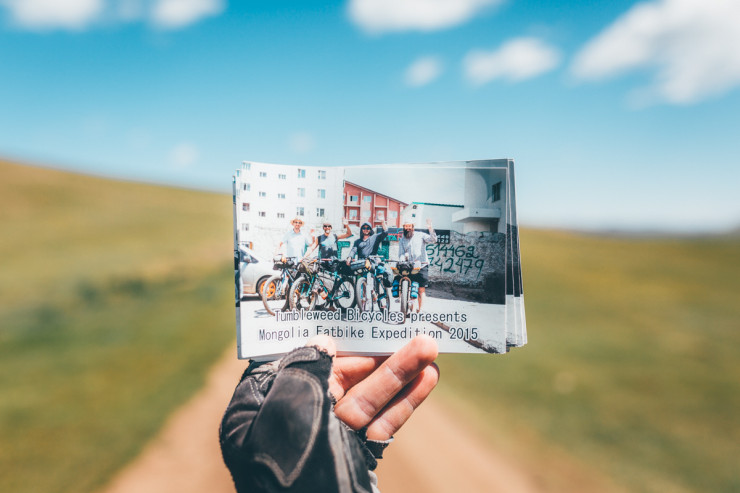
I’ve built up a different bike for each one of my big tours. Each has been a learning experience for what works and what I want to be different, on everything from handling, tire clearance, braze on placement, bag and rack compatibility, etc. I’ve done these trips on 26×2.25” tires, 29×2.0-2.35” tires, 26×4” fatbike tires, and 29×3.0” tire setups, each with their advantages and disadvantages. It was important to me that the Prospector be versatile enough to accommodate a range of wheel and tire options, so that the bike could be used on a trip just about anywhere in the world.
I ride a lot of the trails in Marin County as well as places like Downieville, and enjoy loose and somewhat technical rocky trails. I’ve taken the Prospector prototype and production bikes to these places and it’s a really fun bike, although obviously not as light as more performance-oriented mountain bikes.”
There’s an ever increasing range of capable bikepacking bikes on the market. What would you say makes the Prospector stand out from the rest of the bikepacking crowd?
“Two of the main aspects that set the Prospector apart from other bikepacking offerings are the most seamless and user-friendly integration of the Rohloff Speedhub manageable (while still playing fine with front and rear derailleurs), along with the maximum possible tire and mud clearance available with a 73mm threaded bottom bracket and Shimano mountain crankset.
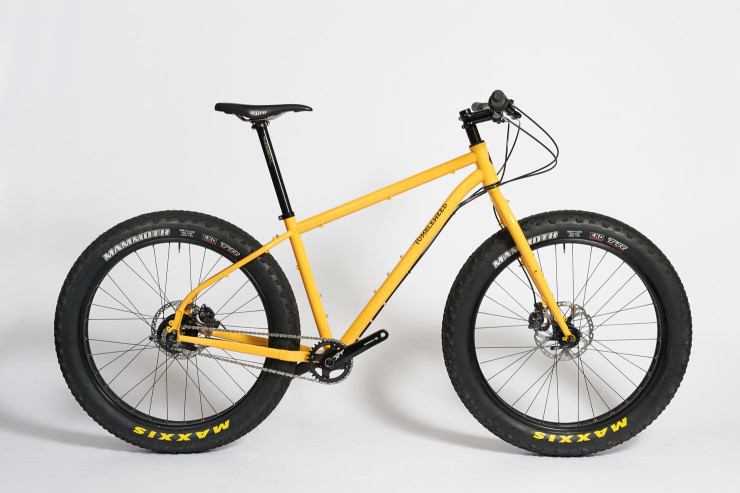
We created a custom hollow bottom bracket yoke and custom dropouts to help make this work. A lot of thought went into the design for the Tumbleweed bottom bracket yoke, which creates room for the crankarms, up to 4” wide tires and allows for plenty of chainring clearance, depending on the drivetrain setup. Similar consideration went into the dropout design, with an integrated slot for the Rohloff OEM axle plate, a commonly available removable derailleur hanger that uses a chainring bolt instead of a small screw, and eyelet placement that allows for a wider range of standard rear racks to be used with plus or fat tires. We even created custom chainstay moulds to maximize the tire and crank arm clearance.

As for the rest of the bike, I wanted it to be as reliable and trouble-free as possible. I approached Phil Wood about creating a special 73mm version of their beautiful eccentric bottom bracket insert for this bike, which they graciously agreed to do. It’s a simple, precision made piece without any wedges or moving parts, just a couple of beefy set screws locking everything in place from the bottom bracket shell. I’ve used this system on my custom Retrotec touring bike for years without a single problem and knew that it had to find it’s way into the Prospector. Using an eccentric BB keeps the rear end of the bike locked into place, and allows for half an inch of BB height adjustment depending on the wheel/tire size being used, and for rigid or suspension fork setup. The stock fork has the same 135mm dropout and rear disc brake spacing as the frame, so the front and rear wheels are interchangeable. I’ve been using either a single speed rear mountain bike hub or a Schmidt SON 28 135mm dynamo hub on my prototype and demo bikes.
The Prospector geometry is pretty neutral for a mountain bike: the headtube is 69.5 degrees, but I gave the fork an offset of 53mm in order to keep the trail in the low to mid 80mm range, which I like for lively handling while loaded up with gear. I find that loaded bike handling is highly dependent on packing style and weight distribution, so some experimentation will be necessary to fine tune your ride.”
Putting your ideas where your mouth is must be a daunting process. Tell us about the process of turning an acorn of an idea to a fully-fledged bike company.
“Launching Tumbleweed has been an all-consuming undertaking. I think that without the nudging from friends and family, the company would have just stayed an idea. I was constantly talking about the concept for the Prospector, and even encouraged my boss Jason Montano of Broakland bikes to make it. He wasn’t interested in fatbikes and was sick of hearing me fantasize about this ultimate mountain touring bike – so instead he encouraged me begin the process of actually creating it. I started reaching out to friends in the bike industry who could help me make this dream into a reality. I began by looking for an engineer who could make a 3D model to see if everything I wanted to do would actually fit together. I worked with Jason Faircloth, who was an engineer for Marin Bikes, and together we created the initial prototype design, including the first version of the BB yoke that would allow a 26×4” or 29×3” tire work with a 73mm bottom bracket and Shimano XT cranks.
Next I approached Cameron Falconer, a terrific local framebuilder who I’ve known for a few years, about building prototype frames for an upcoming tour across Mongolia that I had been planning to test the bike design. Cameron is one of the biggest reasons that these bikes exist and I am eternally grateful. He was willing to consider building these bikes for me that required really tight tolerances, since the tire clearance was stretched to the absolute limit. He also arranged to have the first machined BB yokes made, which was great since the quantities I needed were very limited and most machinists wouldn’t bother with such a small job. I think Cameron and I both acquired some new grey hairs during the process of building these prototypes.

After my six week trip to Mongolia testing the prototype bike and knowing what I wanted to change for the finished product, I definitely underestimated the time and effort that would be required. It was extremely important for me to produce the very best quality frameset possible for this application, without worrying about what the price point would be. I’m highly critical of the details on bikes and wanted to put my name on something I’d be really proud of. I needed somebody experienced who could guide me through the production process and introduce me to the best people to make everything happen. Grant Petersen introduced me to Tim Kreuger, who was a product manager for Salsa Cycles and now runs several of his own companies. Tim introduced me to Anna Schwinn, a former engineer for All City Cycles, and together we began the journey of refining and improving upon the original prototype design as well as finding partners who could meet the requirements for fabrication.
Part of making this bike into a production model was designing new frame parts that weren’t available off the shelf, to optimize both Rohloff compatibility and tire clearance, while still maintaining the option to run derailleurs in certain configurations. This involved creating a new set of dropouts, custom-molded chainstays and a hollow cast yoke. I’m really proud of these parts, they are functional and beautiful. Manufacturing these bikes on a batch scale has enabled me to make them exactly how I wanted with minimal compromises.”

Any other products in the pipeline?
“Definitely, there will be a couple of new parts/accessories announced later this year.”
Any bikepacking plans for the future?
“I’m planning on a couple of trips this year, including a tour in Iceland on production Prospectors with some of the same guys I rode with in Mongolia last year. We’re hoping to make a follow-up to Bikepacking the Mongolian Steppe, Jay Ritchey’s award-winning documentary of the journey and our experiences.”
Ordering
If you’d like to order a Prospector, head over to the Tumbleweed website. Customers can order a frameset ($1450), a frameset with Rohloff Speedhub Speedhub ($2650), or a complete bike.
Complete bikes are custom assembled; there’s a standard/suggested build kit that runs around $4100-$4350 depending on rim/tire choice and extras like the SON 28 dynamo hub. The delivery date schedule for the main batch is mid-March. There are two colours available: Desertglow and Turquoise, as pictured in our test bike below.
Sizing
In terms of sizing, my XL test bike is similar in effective top tube length to the likes of a Surly Wednesday (so longer than a Pugsley), making its geometry suited to running a short stem. Perhaps thanks to the long headtube and the frame is suspension corrected, I found standover height to be slighter greater than the equivalent Surly XL frames I’m used to. A geometry chart can be found at the bottom of this link.
Wheel sizes
Confused about wheel sizes? Here’s my personal take: I’ve found the 29+ format rules the roost in how well it rolls – it smooths out rough terrain to the point that suspension is often unnecessary for bikepacking purposes. Its sheer size limits saddlebag and front roll clearance on smaller frames though. 4in tires are a great omniterra choice – they excel across soft terrain and big rocks, they’re perfectly respectable on dirt, but they’re draggy on pavement and prone to autosteer, depending on tire choice. For better or for worse, full fat is also a guaranteed crowd magnet. 27.5+ is certainly the most nimble of the three choices. In terms of how it steers, 27.5+ feels most like a ‘normal’ mountain bike, while still offering extra traction and comfort. For overseas travel purposes, a 27.5+ bike is more compact to pack too. Tire choice and availability are also worth considering, dependent on where in the world you’re headed.

First Impressions on the Tumbleweed Prospector
With a few weeks riding the Prospector under my belt, first impressions are extremely good. Tumbleweed’s obsessive attention to detail really stands out, as does a stoutness in the frameset that will reassure anyone seeking the road less traveled. I’m especially heartened to see the generously proportioned head tube, helping provide a comfortable fit without the need for a stack of headset spacers. Even though the frame is suspension compatible – which often encroaches on internal triangle space – there’s ample space for a roomy framebag too. I’ve been running a 29+ setup and haven’t felt the need for front suspension, though I can see the appeal, particularly with 27.5+ hoops.
Speaking of different wheel sizes, the ability to tweak the bottom bracket height and resulting pedal-ground clearance, depending on the outside diameter of the tires being run, adds greatly to the Prospector’s appeal. The eccentric bottom bracket also means the Prospector can be fine-tuned to suit different riding styles and intentions. Positioning it in the lowest spot works especially well for touring. Rotating it round to a higher point helps clear rocky terrain. As for adjusting chain tension and slotting in a Rohloff hub, it’s a frustration-free affair, something that can’t always be said of non Rohloff-specific frames. And for anyone who fears creaky EBBs… I’ve no issues to report. Tire clearance is perfectly reasonable in 29+/4in mode and very generous with 27.5x3in tires – though the chainline is relatively tight with a 4in tire and a Rohloff drivetrain, as you might expect.
So far I’ve ridden the Prospector around my local trails and dirt roads, as well as loading it up for some test rides, all in its 29+ guise. In a nutshell, it handles in an engaging way, one that encourages me to extend my loops and keep riding – always a good litmus test. Of course, no XL steel frame, fitted with a Rohloff and a dynamo hub, is ever going to be the quickest bike round the race course. I can see the appeal of running the Prospector with a lighter 1x drivetrain and ‘plus’ tires for dedicated trail use, swapping out the Rolloff for more strenuous, overseas undertakings – a relatively quick and easy conversation. Still, given Tumbleweed’s mantra – Ride It All – the Prospector’s certainly no slouch set up as is, even in full expedition mode.
Having ridden the US-made prototype bike in Mongolia, Peru and Bolivia – which, incidentally, handled everything I threw at it with easy nonchalance – I can already see that this pre-production version has seen an extensive round of improvements. Tumbleweed tells us that the final frameset will undergo other minor refinements. Priced at $1450, the net result of such a demanding eye for the minutia, as well as the use of quality, custom parts, is that the Tumbleweed Prospector is not a cheap frameset. But given how nicely thought through it is, there’s no doubt as to where your hard earned dollars are going.
The Prospector is a bike that fills me with the confidence to go places, so check back for a full review further down the line.
Please keep the conversation civil, constructive, and inclusive, or your comment will be removed.
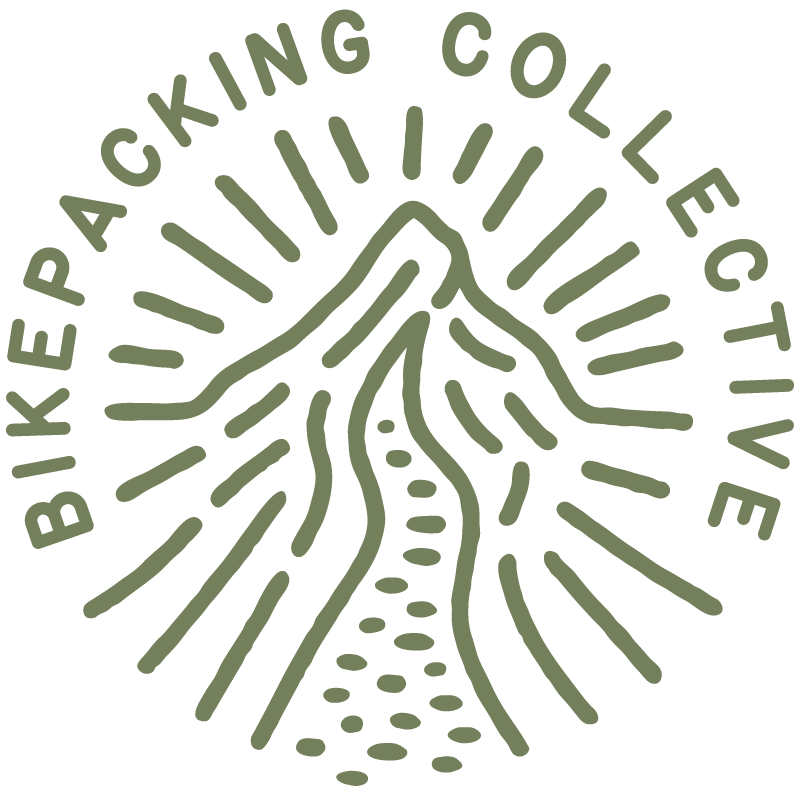
We're independent
and member-supported.
Join the Bikepacking Collective to make our work possible:









